《固体物理学》课程教学课件(PPT讲稿)Chapter 6 Electron motion in the crystal 6.4 The electron motion in a constant electric field 6.5 Band structure of conductor, insulator and semiconductor
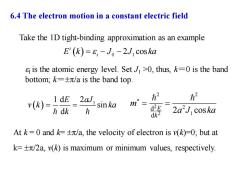
6.4 The electron motion in a constant electric field Take the 1D tight-binding approximation as an example E'(k)=E;-Jo-2J coska s is the atomic energy level.SetJ>0,thus,k=0 is the band bottom;k=±π/a is the band top. ()=I ds2asinka h2 h2 ,m*= h dk h d2E dk2 2a2J coska At k=0 and k=tn/a,the velocity of electron is v(k)=0;but at k=+n/2a,v(k)is maximum or minimum values,respectively
Take the 1D tight-binding approximation as an example ( ) 0 1 2 cos i E k J J ka i = − − I is the atomic energy level. Set J1 >0, thus, k=0 is the band bottom; k=/a is the band top. ( ) 1 1 d 2 sin d E aJ v k ka k = = 2 2 2 1 2 2 d d 2 cos E k m a J ka = = At k = 0 and k= /a, the velocity of electron is v(k)=0; but at k= /2a, v(k) is maximum or minimum values, respectively. 6.4 The electron motion in a constant electric field
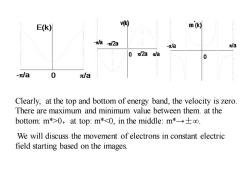
E(k) m (k) -h-2a -元归 a 0 2a xa -元da 0 π/a Clearly,at the top and bottom of energy band,the velocity is zero. There are maximum and minimum value between them.at the bottom:m*>0,at top:m*<0,in the middle:m*co. We will discuss the movement of electrons in constant electric field starting based on the images
Clearly, at the top and bottom of energy band, the velocity is zero. There are maximum and minimum value between them. at the bottom: m*>0,at top: m*<0, in the middle: m*→±∞. We will discuss the movement of electrons in constant electric field starting based on the images
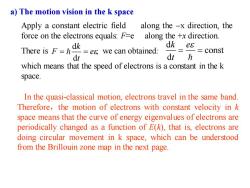
a)The motion vision in the k space Apply a constant electric field along the -x direction,the force on the electrons equals:Fe along the +x direction. k dk es There is F=h =eg we can obtained: =const dt dt h which means that the speed of electrons is a constant in the k space. In the quasi-classical motion,electrons travel in the same band. Therefore,the motion of electrons with constant velocity in k space means that the curve of energy eigenvalues of electrons are periodically changed as a function of E(k),that is,electrons are doing circular movement in k space,which can be understood from the Brillouin zone map in the next page
In the quasi-classical motion, electrons travel in the same band. Therefore,the motion of electrons with constant velocity in k space means that the curve of energy eigenvalues of electrons are periodically changed as a function of E(k), that is, electrons are doing circular movement in k space, which can be understood from the Brillouin zone map in the next page. a) The motion vision in the k space Apply a constant electric field along the –x direction, the force on the electrons equals: F=e along the +x direction. There is , we can obtained: which means that the speed of electrons is a constant in the k space. d d k F e t = = d const d k e t = =

When electrons meet the Boundary of Brillouin Zone k=,the following situation happen: The difference betweenand reiprocal lattice oractually represent the same state.The electron shif from=and shift in from=to form a circular motion. eE k The electron motion in a constant electric field
When electrons meet the Boundary of Brillouin Zone , the following situation happen: The difference between and is a reciprocal lattice vector , actually represent the same state. The electron shift out from and shift in from to form a circular motion. k a = k a = k a = − k a k = a = − 2 a

when t=0,electron is located at the band bottom,k=0,m*>0. The velocity of electrons v can be accelerated by external force. When arrival at k=z/2a m*->o,v reach maximum.When k go over this point,m*0,so that the reverse speed decreases until k-0 and v-0.This is the speed of oscillation in a constant external field.(See above diagram
when t=0, electron is located at the band bottom, k=0, m*>0. The velocity of electrons v can be accelerated by external force. When arrival at , m*→∞, v reach maximum. When k go over this point, m*0, so that the reverse speed decreases until k=0 and v=0. This is the speed of oscillation in a constant external field. (See above diagram k a = 2 k a = k a = − 2
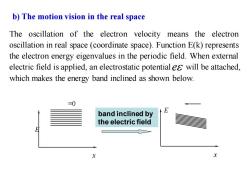
b)The motion vision in the real space The oscillation of the electron velocity means the electron oscillation in real space (coordinate space).Function E(k)represents the electron energy eigenvalues in the periodic field.When external electric field is applied,an electrostatic potential es will be attached, which makes the energy band inclined as shown below. band inclined by the electric field
b) The motion vision in the real space E x =0 E x band inclined by the electric field The oscillation of the electron velocity means the electron oscillation in real space (coordinate space). Function E(k) represents the electron energy eigenvalues in the periodic field. When external electric field is applied, an electrostatic potential will be attached, which makes the energy band inclined as shown below. e

The periodic oscillations of the electron velocity is in real space When t=0,electron is at point A,the band bottom of lower band. In the presence of external field force,electrons move along A->B >C,corresponding from k=0 to k=".The electron meet energy gap (equal to point A)at C point.In the classical movement, electrons are constrained in one energy band,so it will be reflected back.The electron transmit as C->B->A,that is,a oscillation process is completed during the movement from k=-z/a to k=0
A B C When t = 0, electron is at point A, the band bottom of lower band. In the presence of external field force, electrons move along A→B →C, corresponding from k = 0 to . The electron meet energy gap (equal to point A) at C point. In the classical movement, electrons are constrained in one energy band, so it will be reflected back. The electron transmit as C→B→A, that is, a oscillation process is completed during the movement from k= –π/a to k = 0. k a = The periodic oscillations of the electron velocity is in real space
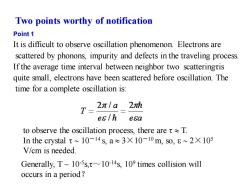
Two points worthy of notification Point1 It is difficult to observe oscillation phenomenon.Electrons are scattered by phonons,impurity and defects in the traveling process. If the average time interval between neighbor two scatteringtis quite small,electrons have been scattered before oscillation.The time for a complete oscillation is: T- 2π/a2 eslh esa to observe the oscillation process,there aretT. In the crystal ~10-14s,a3X10-10m,so,s~2X 105 V/cm is needed. Generally,T~10-5s,t10-14s,109 times collision will occurs in a period?
Point 1 It is difficult to observe oscillation phenomenon. Electrons are scattered by phonons, impurity and defects in the traveling process. If the average time interval between neighbor two scatteringτis quite small, electrons have been scattered before oscillation. The time for a complete oscillation is: to observe the oscillation process, there are T. In the crystal 10-14 s, a 3×10-10 m, so, 2×105 V/cm is needed. Generally, T ~ 10-5 s,τ~10-14s, 109 times collision will occurs in a period? Two points worthy of notification

Point 2 all electrons will return when arriving at the energy gap. According to quantum mechanics,some transmission probabilities exist,and only part of electrons will be reflected back π2 transmission probability sexp For insulator or semiconductor,a strong electric field will be established inside the materials,leading to electron interband tunneling,known as the electrical breakdown or Zener effect Similiar to the electrical breakdown,the strong magnetic field will cause the magnetic breakdown
Point 2 all electrons will return when arriving at the energy gap. According to quantum mechanics, some transmission probabilities exist, and only part of electrons will be reflected back. For insulator or semiconductor, a strong electric field will be established inside the materials, leading to electron interband tunneling, known as the electrical breakdown or Zener effect. Similiar to the electrical breakdown, the strong magnetic field will cause the magnetic breakdown. transmission probability
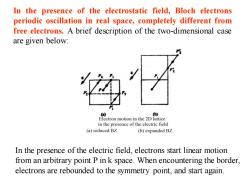
In the presence of the electrostatic field,Bloch electrons periodic oscillation in real space,completely different from free electrons.A brief description of the two-dimensional case are given below: Electron motion in the 2D lattice in the presence of the electric field (a)reduced BZ (b)expanded BZ In the presence of the electric field,electrons start linear motion from an arbitrary point P in k space.When encountering the border, electrons are rebounded to the symmetry point,and start again
In the presence of the electrostatic field, Bloch electrons periodic oscillation in real space, completely different from free electrons. A brief description of the two-dimensional case are given below: In the presence of the electric field, electrons start linear motion from an arbitrary point P in k space. When encountering the border, electrons are rebounded to the symmetry point, and start again
按次数下载不扣除下载券;
注册用户24小时内重复下载只扣除一次;
顺序:VIP每日次数-->可用次数-->下载券;
- 《固体物理学》课程教学课件(PPT讲稿)Chapter 6 Electron motion in the crystal 6(supplement - a more concise description of quasi-momentum).ppt
- 《固体物理学》课程教学课件(PPT讲稿)Chapter 6 Electron motion in the crystal 6.1 The quasi-classical description of Bloch electrons 6.2. Electron quasi-momentum 6.3 The accelerated velocity and effective mass.ppt
- 《固体物理学》课程教学课件(PPT讲稿)Chapter 5 band theory 5.4 Tight Binding Approximation(TBA).ppt
- 《固体物理学》课程教学课件(PPT讲稿)Chapter 5 band theory 5.3 Nearly Free Electron 5.4 BZ and energy bands.ppt
- 《固体物理学》课程教学课件(PPT讲稿)Chapter 5 band theory 5.5 The symmetry of bands.ppt
- 《固体物理学》课程教学课件(PPT讲稿)Chapter 4 lattice dynamics and lattice capacity 4(supplement - Thermal Expansion of Glass).ppt
- 《固体物理学》课程教学课件(PPT讲稿)Chapter 4 lattice dynamics and lattice capacity 4.6 Anharmonic Effects 4.7 Equation of states for Lattice 4.8 Experimental methods for the determinations of lattice vibration spectroscopy.ppt
- 《固体物理学》课程教学课件(PPT讲稿)Chapter 5 band theory 5.1 general background and approximations 5.2 Bloch’s Theorem.ppt
- 《固体物理学》课程教学课件(PPT讲稿)Chapter 4 lattice dynamics and lattice capacity 4.5 Heat capacity of the lattice.ppt
- 《固体物理学》课程教学课件(PPT讲稿)Chapter 4 lattice dynamics and lattice capacity 4.1 Normal Modes of Vibration 4.2 Density of States 4.3 Harmonic approximation and normal mode coordinates 4.4 phonon.ppt
- 《固体物理学》课程教学课件(PPT讲稿)Chapter 3 Interatomic Bonding 3.1 General crystal binding 3.2 typical binding.ppt
- 《固体物理学》课程教学课件(PPT讲稿)Chapter 3 Interatomic Bonding 3(Supplement - Rules of crystal binding).ppt
- 《固体物理学》课程教学课件(PPT讲稿)Chapter 3 Interatomic Bonding 3.3 The cohesive energy for ionic crystal.ppt
- 《固体物理学》课程教学课件(PPT讲稿)Chapter 2 Wave Diffraction & the Reciprocal Lattice(2.1-2.5).ppt
- 《固体物理学》课程教学课件(PPT讲稿)Chapter 2 Wave Diffraction & the Reciprocal Lattice 2.6 X-Ray Diffraction Methods 2.7 Applications of XRD.ppt
- 《固体物理学》课程教学课件(PPT讲稿)Chapter 2 Wave Diffraction & the Reciprocal Lattice(supplement - Review & Overview of X-Rays).ppt
- 《固体物理学》课程教学课件(PPT讲稿)Chapter 1 Crystal Structure 1.9 Elements of Symmetry 1.10 Space groups 1.11 7 crystal system and 14 Bravis Lattice.ppt
- 《固体物理学》课程教学课件(PPT讲稿)Chapter 1 Crystal Structure(Supplement - microstructure and crystal system).ppt
- 《固体物理学》课程教学课件(PPT讲稿)Introduction.ppt
- 《固体物理学》课程教学课件(PPT讲稿)Chapter 1 Crystal Structure 1.1 Elementary Crystallography 1.2 Crystal Structure ≡ Lattice + Basis 1.3 Lattice Translation Vectors 1.4 Non-Bravais Lattices 1.5 Wigner-Seitz Method.ppt
- 《固体物理学》课程教学课件(PPT讲稿)Chapter 7 The electronic theory of metal(supplement - Sommerfield expansion).ppt
- 《固体物理学》课程教学课件(PPT讲稿)Chapter 7 The electronic theory of metal 7.1 Fermi statistics and the heat capacity of electron 7.2 Work function and contact potential.ppt
- 《固体物理学》课程教学课件(PPT讲稿)Chapter 5 band theory 5.6 Density of states(DOS)and Fermi surface 5.7 the electrons in the crystal 5.8 the experimental results for DOS.ppt
- 《近代物理实验》课程教学大纲.doc
- 《近代物理实验》课程教学资源(PPT课件讲稿,共五部分).ppt
- 《工程光学》课程教学大纲 Engineering Optics.doc
- 安徽大学:《工程光学》课程授课教案(讲义,共十三章,授课教师:李桂华).doc
- 《工程光学》课程实验指导书(共六个实验).doc
- 《量子力学》课程教学课件(讲稿)Chapter 4 态和力学量的表象 The representation for the states and dynamical variable.pdf
- 《量子力学》课程教学课件(讲稿)Chapter 1 绪论 Quantum mechanism(量子力学的诞生).pdf
- 《量子力学》课程教学课件(讲稿)Chapter 2 波函数和薛定谔方程 The wave function and Schrödinger Equation.pdf
- 《量子力学》课程教学课件(讲稿)Chapter 3 量子力学中的力学量 The Dynamical variable in Quantum Mechanism.pdf
- 《量子力学》课程教学课件(讲稿)Chapter 6 散射 Scattering.pdf
- 《量子力学》课程教学课件(讲稿)Chapter 5 微扰理论近似方法 Approximation(本征值问题的似解).pdf
- 《量子力学》课程教学课件(讲稿)Chapter 7 自旋与角动量、全同粒子体系 Spin and undistinguished similar particles.pdf
- 《量子力学》课程教学资源(习题解答)第七章 自旋与角动量、全同粒子体系.doc
- 《量子力学》课程教学资源(习题解答)第三章 量子力学中的力学量.doc
- 《量子力学》课程教学资源(习题解答)第二章 波函数和薛定谔方程.doc
- 《量子力学》课程教学资源(习题解答)第五章 微扰理论.doc
- 《量子力学》课程教学资源(习题解答)第四章 态和力学量的表象.doc
